Dinger's Aviation Pages
From "Weaver" to "Ace".
The Gloster Single-engined Jet Projects

The Gloster Single-engined Jet Projects

The Gloster E1/44 single-engined jet fighter, the result of project "Ace"; too late for WW2, too early for the Cold War.
In Britain, the invention of the gas-turbine jet engine as a means of powering aircraft is usually credited to Frank Whittle. Amongst many other claimants are the German Hans von Ohain, and the Frenchman Maxime Guillaume (even in Britain, there is another contender, Alan Arnold Griffiths). In truth, the gas turbine is one of the simplest sorts of propulsion imaginable, its adoption many years earlier only being held back by a lack of metallurgical knowledge of how to withstand the heat involved. It is interesting to speculate that, if we ever do make radio contact with other advanced life-forms in our galaxy, many might have skipped over either the steam engine or internal-combustion engine (or both) and gone straight to the much simpler gas turbine, if they had the requisite alloys or exotic ceramics available. Anyone who remembers the "Scrapheap Challenge" TV show will recollect jet engines being built from scratch (for example see the second half of the YouTube video at <this link> ) but those engines would only run for a minute or so before either disintegrating or melting. Advances in making alloys more resistant to the increasing heat in high-performance piston aero-engines¹ made it possible for Whittle to demonstrate a jet engine that worked for over 20 minutes and it was this that prompted the Air Ministry, in 1939, to order an experimental aircraft to try this new engine in.
With war looming, most British aircraft companies had full order books and design staff already committed to other projects. The choice fell on Gloster aircraft, and their chief designer, George Carter. The Gloster company had been swallowed up by the Hawker-Siddeley Group in 1934 but fortunately, a full design team was retained, despite losing Gloster's star designer Henry Folland. It has been suggested that the initial choice of Glosters was prompted by the belief that the design they had most recently been working on, a twin-boom pusher design in response to Air Ministry Specification F18/37, similar in layout to the later SAAB 21, could be easily converted to use a jet engine (the SAAB 21 was successfully redesigned to use a jet engine as the SAAB 21R) . Whittle first met Carter at the Gloster factory in April 1939, where Carter was told about the secret engine project. Carter was intrigued by the idea of a jet aircraft (apparently Carter himself had patented an idea for a gas turbine engine when he was 22 ²) and started looking at design studies prior to an official contract with the Air Ministry. This was agreed in the following October with Carter pitching two alternative designs to the Air Ministry specification E28/39, the whole project being given the code name "Weaver".
The first design was surprisingly prescient, combining a streamlined fuselage with a mid-wing, slightly inverted gull-wing. It featured a teardrop cockpit canopy. Two air intakes for the jet engine were located low-down on either side of the nose and the jet engine exhaust exited at the rear of the fuselage via a long tailpipe. The design had a tricycle undercarriage with a nose wheel, then still a novelty in British aircraft. It was a very futuristic design, especially considering the last Gloster design to reach production had been the biplane Gladiator.
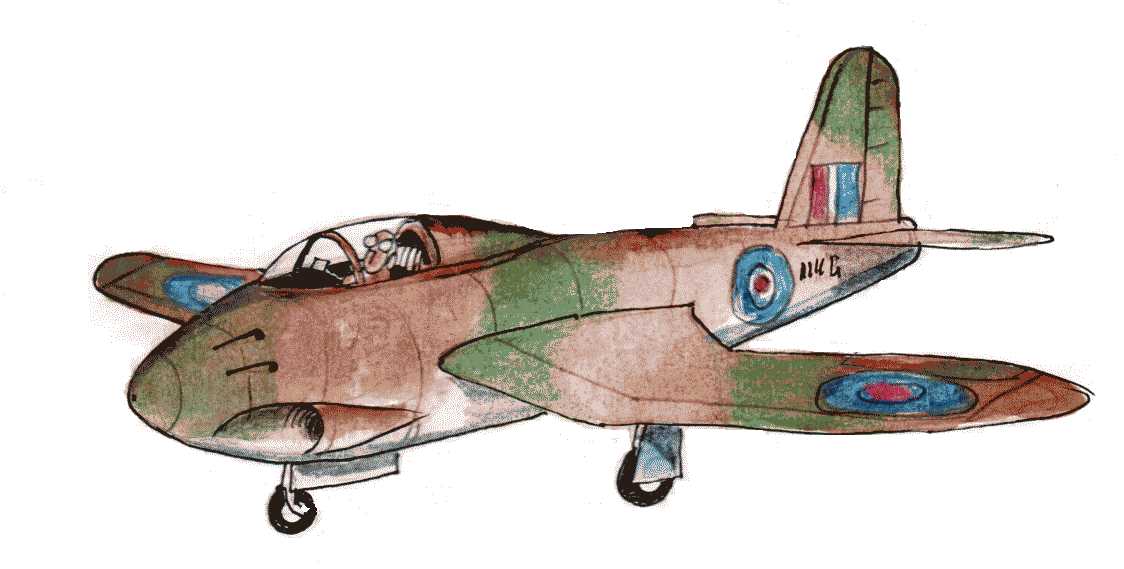
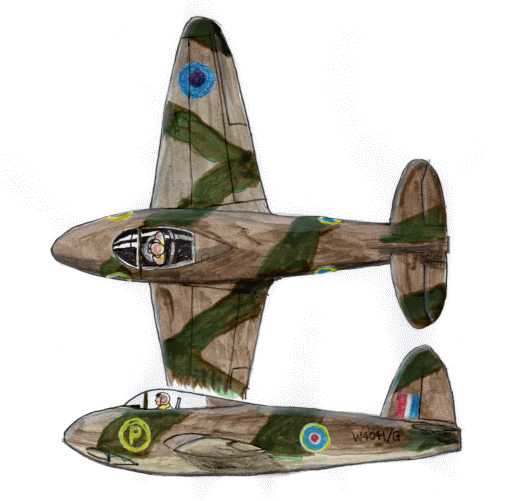
First outline design for project "Weaver". Remarkably advanced for the time with nosewheel landing gear and long tailpipe.
The second design put forward was more reserved, in that it avoided any unforeseen problems with the long tailpipe by having the tail end in an overhanging boom. It had a single air intake at the front of the fuselage and the cockpit canopy was faired into the spine that joined the tail boom. This design solution was very close to that adopted by the Soviet Yak 15 and Mig 9 early jet fighters.
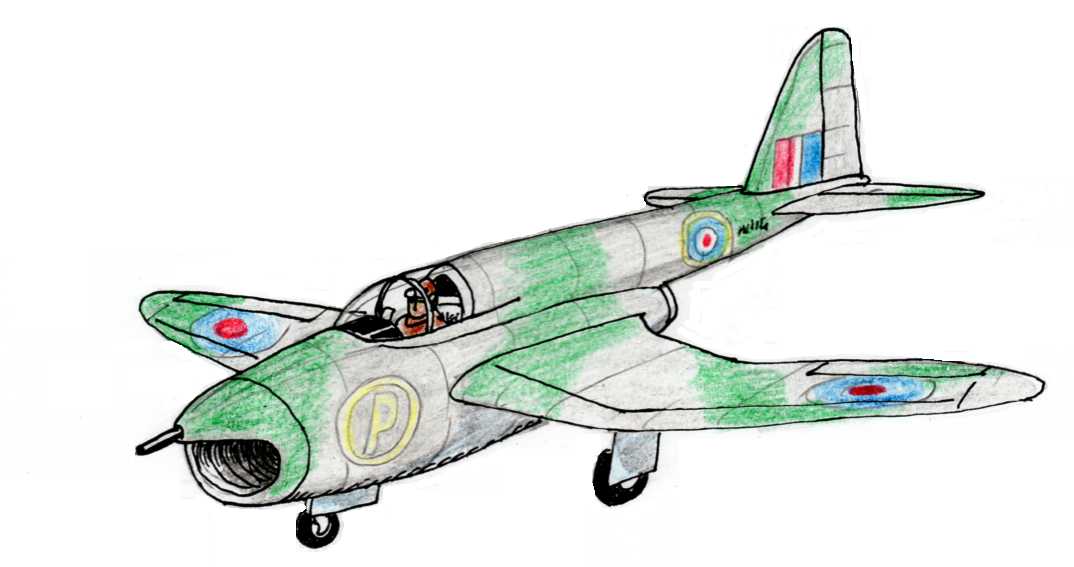
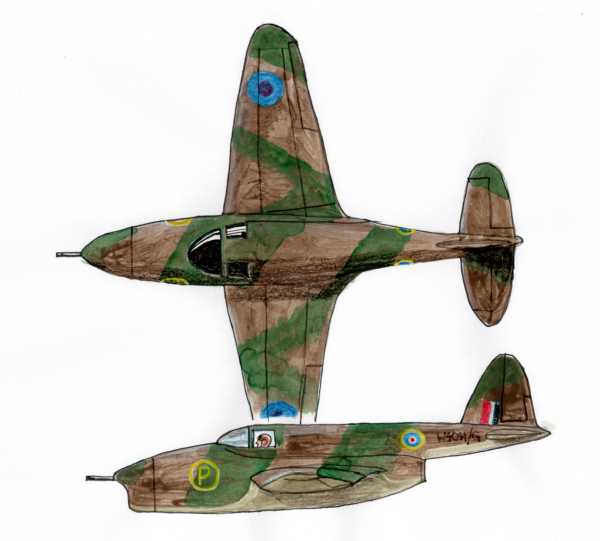
Second outline study for project "Weaver" produced a design similar to the first Soviet jets.
Although experimental, both designs were intended to be converted into short-range interceptors with minimum armament for use in an emergency. The first design with machine guns mounted in the nose, the second with a single 20 mm cannon in a small fairing lip above the air intake.
Perhaps surprisingly, the more ambitious first design was chosen for development. It evolved into the E28/39 "Pioneer", losing the twin air intakes in favour of a single large opening in the nose of the aircraft.
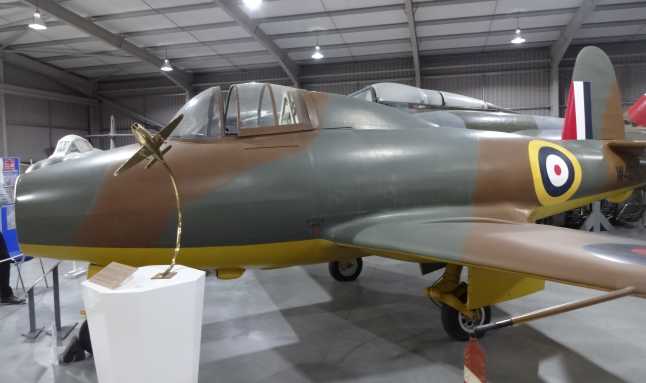
Two prototypes of the E28/39 Pioneer was ordered in February 1940. The first prototype (W4041) took some short "hops" at the Gloster airfield at Hucclecote in April 1941, after which it went to Cranwell (which had longer runways and was a more secure location) and made its first proper flight in May 1941. Testing of the first prototype and the second (W4046) continued through until 1944, trying out different wing sections and engines.
Even before the first E28/39 had flown, Carter started work on an operational fighter design to make proper use of the new jet engines. He chose to use two engines mounted in nacelles in the wings, a configuration that allowed for heavy armament to be housed in the nose, and which took account of the relatively low thrust available from the early Whittle engines (although it was anticipated this would be greatly increased in future developments). Carter's experience with the earlier F9/37 twin piston-engined fighter prototypes must have helped him with the configuration. Carter presented his ideas for the new fighter in August 1940 and the Air Ministry wrote specification F9/40 around it, ordering 12 prototypes in February 1941. This went on to be the famous "Meteor" fighter (first flight March 1943), the only Allied jet to see service in WW2 (albeit very briefly). The Meteor stayed in production until the mid-1950s and saw service in the RAF until the 1960s as a night-fighter and trainer.

Gloster Meteor, the mainstay of the RAF in the 1950s.
In 1942, the first of the more powerful next-generation engines, the Halford H-1 (later to become the deHavilland Goblin), started to be tested, and other advanced designs from Whittle, Metrovick (the first British axial-flow jet engine), Rolls-Royce and GEC in America were all expected to be available soon. This made it possible to consider a single-engined jet fighter design. Initial work was done by George Carter at Gloster along with Jimmy Lloyd at Armstrong Whitworth (part of the same Hawker-Siddeley Group) who presented their estimates of performance to the Air Ministry who quickly seized on the possibilities of the new design and wrote specification E5/42 around the project, which was allocated the code-name "Ace". George Carter was able to delegate responsibility for the Meteor and so took control of the new project. The new design was based on using the Halford H1 engine but was to be built in such a way as to be able to accomodate any of the other high-powered jet engines expected to mature shortly. The Air Ministry was very excited about the possibilities of project "Ace" and declared it should be given priority over the Meteor if resources became stretched. Three prototypes were ordered (serial numbers NN648, NN651 and NN655).
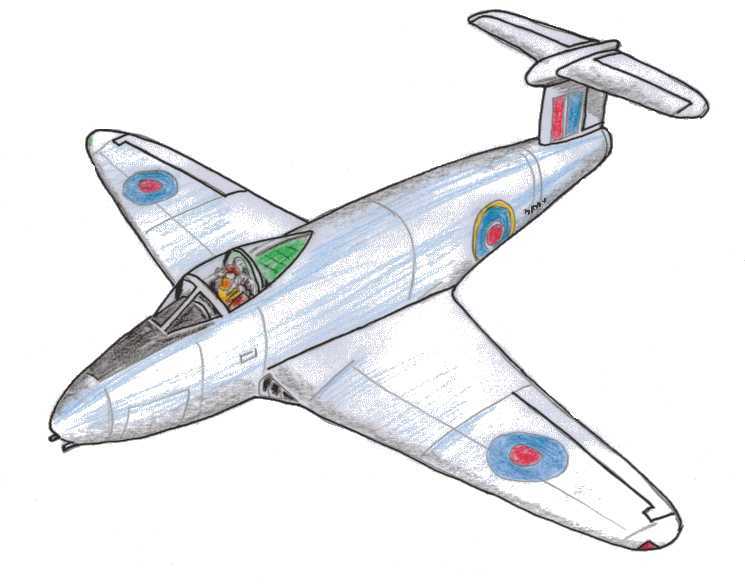
E5/42, the first "Ace". It differed from the later E1/44 by having smaller wing-root engine intakes and a "T" tail.
A parallel project called the P150 "Rocket" was mooted by Gloster in August 1943 that envisaged replacing the single engine in the Ace with two smaller side-by-side Rolls-Royce B37 Derwent jets, fed by larger intakes either side of the nose.
Meanwhile, the Meteor proved to be very tractable in accepting larger engines, first the Whittle designed (but Rolls-Royce produced) Welland, then the Rolls-Royce Derwent. With the Royal Air Force going onto offensive operations the longer range and twin-engined safety of the Meteor was seen as increasingly desirable. So the order of priority was reversed, with the Meteor being given precedence and the Ace project sidelined, while the Rocket project was dropped altogether.
In 1944, de Havilland started testing their H2 engine (later renamed "Ghost"), while Rolls-Royce started development of what was to become the Nene jet engine, both of which promised to have twice the thrust of the earlier jets. Both the H2 and Nene were too big to fit into the nacelles of the Meteor (the Nene was later scaled down to fit the Meteor, in which form it was known as the Derwent V). This prompted the earlier E5/42 design to be enlarged, initially to take the H2 engine, leading to specification E1/44 being issued for the new design. Three prototypes were ordered (allocated serial numbers SM801, SM805 and SM809 and given the SBAC designation "GA1") and construction begun. However, changes in the engine layout meant that it would not fit into the initial design of airframe, so the first two prototypes already under construction were scrapped (SM801 and SM805) and an additional three prototypes were ordered (TX145, TX148 and TX150) while construction of SM809 began in the revised configuration. A new SBAC designation of GA2 was allocated while the earlier project name of "Ace" was retained and the aircraft design was given the Gloster project number P181. The H2 engine required only a small air inlet, and this would have been accommodated in the wing-root, (similar to the intakes on the deHavilland Vampire). However priority was then switched to the Rolls-Royce Nene engine and the prototypes were all built with the larger intakes, on the side of the fuselage, required by the low-pressure intake of the Nene, this later design was assigned project number P190.
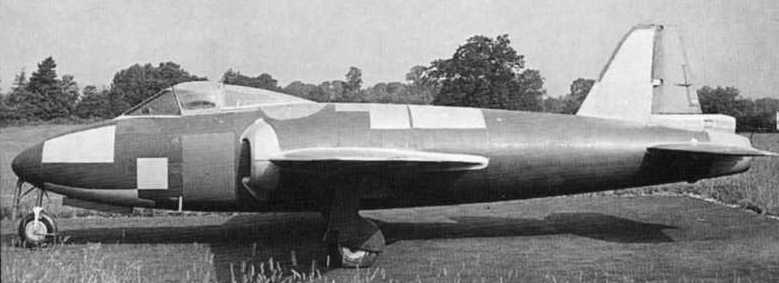
The first E1/44 prototype (SM809) tragically written off in a traffic accident.
By 1944 it was already obvious that victory over the Axis powers was assured. Britain was broke, with its economy in a parlous state, rationing was still in force, and would continue for another decade. The prototype of the de Havilland Vampire single-engined jet fighter had already flown and seemed to meet the needs of the RAF for the foreseeable future. So it was only natural that all unnecessary spending was reined back and the E1/44 project therefore proceeded at a slow pace. Construction of the first P190 prototype (SM809) was only completed in 1947 and tragically the aircraft was destroyed in a traffic accident while being shipped to Boscombe Down for its first flight. The next prototype (TX145) undertook taxiing trials late in 1947 which showed up a violent nosewheel "shimmy", calling for a redesign. TX145 finally took to the air on the 9th of March, 1948 which was marred by a malfunction of one of the undercarriage legs, although the aircraft landed safely. Later trials showed the performance was up to expectation, with a remarkable top speed of 620 mph (998 kph) but there were major handing problems. Some sources say these issues were largely fixed on the next prototype (TX148) which had the tailplane raised from the fuselage to halfway up a larger rudder with a bullet fairing (this is ironic because the original E5/42 had a high mounted "T" tail which might have avoided the issue). The design with a new tail was allocated another Gloster project number: P212. The new tail configuration was so successful it was adopted on the later F8 mark of Meteor where it also helped balance out the extended nose of that aircraft. The last airframe (TX150) was never built to full flying condition, being used for structural testing. TX145 did suffer a crash-landing late in its career (November 1950) following a flame-out of its engine, although it was quickly repaired and was back flying within 2 months.

The Gloster P190 E1/44 Ace first prototype to fly (TX145). Notice the tailplane location on the fuselage.
Production orders for two batches of twenty E1/44 fighters (forty in all, serial numbers VP601-VP620 and VR164-VR183) were placed to production specification 23/46. This stipulated that the wingspan of production aircraft should be reduced and that they should be capable of carrying drop-tanks, bombs and rockets. An ejector seat and provision for a g-suit were also specified. Yet another Gloster design project number was allocated to this production version: P213.

The second prototype to fly, TX148, with the higher tailplane and bullet fairing that solved the handling issues.
The E1/44 was given the nickname the "Gormless" by chief Gloster test pilot Bill Waterton. His memoir "The Quick and the Dead" (published in 1956) was very critical of the Gloster aircraft company and the E1/44 in particular. An account of his first flight in the E1/44, when he encountered undercarriage retraction problems, forms the prologue to his book³. He said the controls of the E1/44 became increasingly heavy at higher speed and he was pretty damning of its performance. However, some of his observations seem open to debate. He said the aircraft was too heavy for the power of its Rolls-Royce Nene engine, yet the published figures show it weighed less than either the Supermarine Attacker or Hawker Sea Hawk which also used the Nene engine, yet both these aircraft saw service, the Sea Hawk, in particular, being judged a very successful aircraft by most accounts. It was a lot lighter than the French Dassault Ouragan fighter that also used the Nene engine. The E1/44 was substantially lighter than the American Navy's Grumman Panther jet which was designed to be powered by a US-produced version of the Nene but ended up with the US version of the more powerful Rolls-Royce RB44 "Tay" engine giving 50% more thrust. The empty E1/44 weighed only 114 lbs (52 Kg) more than an empty Soviet Mig 15 which used the Kuznetsov RD-45 copy of the British Nene engine, albeit it developed more thrust but at the expense of engine lifespan. Bill Waterton also said the E/44 had a 1 to 3 thrust to weight ratio, with the Nene producing 5,000 lbs of thrust which would imply that the E1/44 weighed over 15,000 lbs (6,804 Kg), yet the published figures say that even a fully loaded E1/44 weighed only 11,470 lbs (5,203 Kg). These discrepancies can only be explained if the E1/44 was initially fitted with the less powerful Nene 1 pre-production engine, rather than the 5,000 lb thrust production version. The first Hawker Sea Hawk prototype, which first flew 6 months before the E1/44, used a Nene 1 pre-production engine and suffered from a lack of performance, it also had issues with heavy controls; all its issues were solved by progressive development and the similar issues on the E1/44 might have been expected to be solved in the same way.
The progress of the E1/44 was not helped by George Carter stepping back from design work to take up more senior management roles in the company, eventually becoming a director on the board. Because Hawker and Gloster were part of the same group of companies, the fact that they had two aircraft with approximately the same performance and using the same engine (the E1/44 and the Sea Hawk), it would have seemed logical for one of them to be dropped. Also, at this time Gloster had full order books for the Meteor and had to sub-contract the construction of some of them to Armstrong Whitworth, so there would have been no factory space free for an E1/44 production line anyway. The slow pace of the project and the still precarious state of Britain's economy led to the production orders being cancelled and the two flying prototypes spent their days being used for experimental flying control and braking parachute research at Farnborough before sadly being sent for use as targets on the Shoeburyness weapons range in September 1951.
With no official trial or mock combat reports available, it is hard to know if the brickbats Waterton threw at the E1/44 were deserved, or if the higher tail of the second prototype completely solved the issues of handling. It had neither the super-thin wings of the Miles M.52 (or later Lockheed Starfighter) nor the swept-back wings of such types as the NA F-86 Sabre and Mig-15 required for transonic performance. Neither did it have the all-flying tailplane first developed for the Miles M.52 (a design idea reportedly observed by an American team inspecting the Miles factory and used on the F-86 Sabre and most other tailed transonic and supersonic aircraft that followed). But its tantalising top speed of 620 mph (albeit without armament) and reportedly excellent climbing speed does seem remarkable compared with other straight-wing jets that actually saw service in the 1950s, such as the de Havilland Vampire, Supermarine Attacker, Grumman F9F Panther and P-80 Shooting Star. Britain neglected its defences after WW2 and then when the Korean War started and the Cold War intensified, had to spend millions playing catch-up with its "super-priority" Hunter, Swift, Javelin and Lightning projects. In Korea, the Meteors of the Australian Air Force were badly handled by Soviet Mig-15s (powered by Soviet copies of the Rolls-Royce Nene engine) and Britain had to order Canadair Sabres until the Hunters and Swifts began to come off the production lines. It is tempting to think that a fully developed E1/44 might have provided a useful stop-gap.
Gloster E1/44 Specification.
Max Speed: 620 mph (1,000 kph). Range: 410 miles (660 Km). Ceiling: 44,000 feet (12,000 metres).
Weight empty: 8,260 lbs (3,747 kg). Weight full: 11,470 lbs (5,200 kg). Fuel Capacity 428 imperial gallons (1,950 litres) in 3 tanks.
Length: 38ft 1 inch (11.6 metres). Wingspan: 36 ft 1 inch (11 metres) Height: 18ft 4 inches (5.6 metres)
Weight empty: 8,260 lbs (3,747 kg). Weight full: 11,470 lbs (5,200 kg). Fuel Capacity 428 imperial gallons (1,950 litres) in 3 tanks.
Length: 38ft 1 inch (11.6 metres). Wingspan: 36 ft 1 inch (11 metres) Height: 18ft 4 inches (5.6 metres)
Interestingly, in 1946-47 Gloster collaborated with the Nationalist Chinese government on a jet fighter design called the CXP-1001, very close in configuration to, and plainly a development of, the E1/44. It was to have had a Nene engine in a longer, fuselage with a single air intake in the nose and be armed with four 20mm cannon. The Nationalist Chinese even secured a licence from Rolls-Royce to produce the Nene engine in China. The collapse of the Nationalist government in mainland China forced abandonment of the venture.

The CXP-1001 design featured larger wings with swept-back front edges, a halfway house to tailed deltas like the Javelin and Mig 21.
It should also be remembered that Gloster had actually started work on what was to become the delta-winged, twin-engined Javelin interceptor as early as 1946, with their P222 project which led into the P238, P258 and then the P276. Gloster evidently learnt a lot from data on delta wings recovered from Germany after the war, The Gloster P275 fighter design of 1948 had the same configuration as the Lippisch P13a. They even schemed a delta-winged development of the Meteor, complete with an all-flying tail, as early as 1947 (Gloster design number P262). From 1949 onwards they had their hands full with the development of the Javelin and a planned "thin-wing" successor. The final Gloster traditional single-engined jet design showing any family resemblance to the E1/44 was a study, in 1948, for a transonic research aircraft, with sharply swept wings (61 degrees), powered by an Armstrong Siddeley Sapphire axial-flow engine, that was expected to reach Mach 1.2. Gloster tendered two designs, the first (P284) had a prone (lying down) pilot position in a torpedo-like nacelle in the engine air intake, the second (P285) had a conventional cockpit. The project was hoped to be developed into a fighter in response to Air Ministry Specification F3/48 and with this in mind provision for a 30 mm cannon in each wing-root was incorporated. Gloster was unsuccessful in their bid and in the end specification F3/48 ended up producing the Hawker Hunter ⁴. Gloster did do some provisional work on VTOL designs with multiple lift-engines in 1960 (P505 and P507), some of the last design studies carried out by the company.

The Gloster P285 transonic test design, a prone-position pilot version (P284) was also proposed..
As it is, the only tangable remains of the E1/44 is an outer wing panel from the TX150 airframe used for structural testing before being sent to the Cranfield Institute of Technology. It is in the care of the Midland Air Museum in Coventry.
WHAT IF?
It is sometimes said, that if Frank Whittle had got the backing he deserved, Britain could have had jet fighters in service in time for the Battle of Britain. Although I would not dismiss this as impossible, I do think it highly unlikely given the many technical obstacles that had to be overcome and the chain of events that eventually got Whittle success. Even if Britain had jet fighters in 1940, would that have been a good thing? If Germany had thought Britain had a technical edge, might they have delayed their assault on the Soviet Union until they had finished off Britain for good? A first-generation jet fighter, with the power of Whittle's first models of engine, and without the benefit of the advances in aviation knowledge accrued in the early war years (armament, armour, self-sealing fuel tanks), would have had only a slim advantage over traditional piston-engined fighters, and the disadvantages of the early jet engines' slow acceleration and high fuel use would have been very limiting. It is not impossible to imagine the Luftwaffe adopting the same tactics the Allies used against the German Me262 fighters at the War's end; hanging around their bases to catch them as they took off and landed.
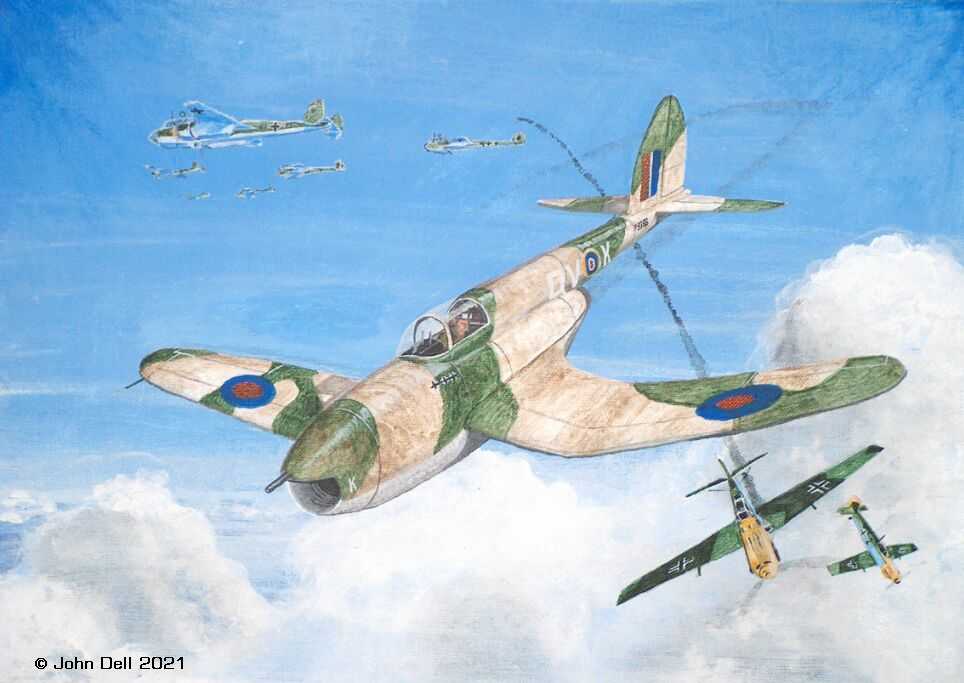
Painting of the early Gloster single-engined "Weaver" project as if it had seen service in 1940/41. With a single 20mm cannon for armament, it would have to rely on "hit and run" tactics. If it had slowed down to dog-fight, or engage targets for more extended periods, its slow acceleration would have made it a sitting duck.
If the war had gone against the Allies later; dragged on until late 1945 or into 1946 (imagine the Soviet Union make a separate peace, or D-Day fails) then a fighter like the E1/44 would surely have found a welcome place in the Allied armoury. Any handling problems would have been overlooked because of its impressive 620 mph (998 kph) top speed, greater than the DH Vampire and contemporary marks of the Meteor. With emergency development and production, it might well have found widespread use, and alongside the Brakemine missile, held the line until the inevitable mushroom cloud over Berlin.

Gloster E1/44 "Aces" surprise a formation of Me262s.
As a fighter in the Korean War, the E1/44 would likely have been much inferior to the Mig-15, especially in transonic performance. However, it might have faired better than the Meteor and the specifications laid out in the original production order (23/46) for the ability to carry drop-tanks, two 1,000 lb (454 Kg) bombs and up to eight rockets might have made it a formidable ground attack fighter for the time.
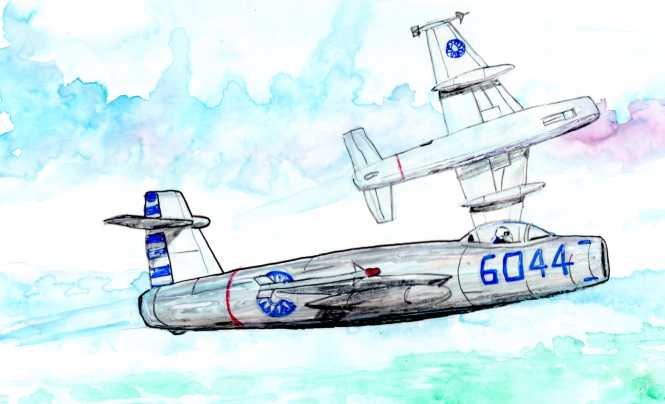
Gloster CXP-1001
The Gloster CXP-1001 seems a very sensible compromise design for a subsonic jet for the 1950s, broadly comparable with the French Dassault Ouragan and US Republic Thunderjet. It might have benefitted from the extra power of the Rolls-Royce RB44 "Tay" engine, giving 50% more thrust.
NOTES
¹ Don't think my comments disparage Whittle's contribution at all, he deserves to be remembered as the "father of the jet engine" for his determination and perseverance; sacrificing his RAF career and health to see his brainchild through to production and use. It is worth remembering that Hans von Ohain had access to both Whittle's patent and Griffiths' research paper. But I stress that the practical use of a jet engine was waiting on the development of (or recognition of the properties of) the necessary alloys. In the case of Whittle's first Jet engine, the alloys required for Whittle's static engine tests were initially "Stayblade" steel, developed for steam turbines, used on the jet turbines. However, this later proved unsatisfactory and had to be replaced by G18B, an alloy developed for piston aero-engine valves. The impeller used an aluminium alloy called RR56, developed for Rolls-Royce aero-engines by High Duty Alloys Ltd. The problem of turbine-blade "creep" that bedevilled German jet engines was solved for Whittle by the use of Nimonic alloys. These Nimonic alloys were developed by a team working under Leonard Pfiel at the laboratories of the Mond Nickel company in Birmingham UK. The Nimonic 80 alloy was a mixture of nickel and chromium with smaller amounts of aluminium, cobalt and other elements. It was first produced by the Henry Wiggins Company of Birmingham (part of the same group of companies as the Canadian Mond Nickel company). Nimonic 80 was available in time to be used on Whittle's W2B engine. The later Nimonic 80A and 90 were used in the Rolls-Royce Derwent and Nene engines and gave Britain a lead in jet engine development until the end of the 1940s. The bombing of the adjacent Docker Paints factory in July 1942 prompted the moving of the Mond Laboratories and the Wiggins Nimonic production facility to Hereford, where their successors, Special Metals Wiggins, still have a factory.
² Mentioned in Chapter 9 of John Gollet's "Genesis of the Jet", see sources below.
³ William "Bill" Waterton's memoir of his time as a test pilot, called "The Quick and the Dead", is highly critical of the Gloster company and the various design flaws in the various marks of Meteor and the prototype Javelins. Bill Waterton was awarded the George Cross after deciding not to eject from a prototype Javelin after a catastrophic failure of the elevators but to crash land it. After being initially trapped in the cockpit he managed to get free but then went back to recover the vital flight recording equipment from the burning aircraft. He was often at odds with the way Gloster approached flight safety and offered his resignation in 1955; it was initially refused with a promise to look into his concerns but shortly afterwards he was dismissed from the company. He then became the aviation correspondent for the Daily Express newspaper and for two years wrote a series of articles that were often scathing of British aviation policy. The publication of his memoir "The Quick and the Dead" caused a minor sensation in 1956. Pressure from advertisers is said to have caused his dismissal from the Daily Express.
⁴ The Hawker Siddeley Group had quite a few different "irons in the fire" from its different design offices. As well as the Gloster P284 and P285 there was the Hawker Hunter and its P1083 derivative, along with the earlier P1069 and P1071 transonic designs and the Armstrong Whitworth AW58. Quite an astonishing range of similar-looking projects from what was, essentially, a single company.
LINKS
Ed Nash YouTube video on the E1/44 (Cheers Ed!)
Cambridge University Engineering Department overview of Frank Whittle (former student there).
CXP-1001 Fighter project profiles.
The E1/44 Prototype TX145 appeared briefly in the 1951 film "No Highway in the Sky": Some screen grabs from the film are on this website.
If you want to see the E1/44 flying in the film "No Highway in the Sky" it occurs about 18 minutes into the film and only takes a few seconds during which it flies overhead and does an aileron roll, then lands with a braking parachute and taxis.The whole film can usually be found on YouTube. The film has been often shown on the UK "Talking Pictures" TV channel. - The same sequence is in Ed Nash's YouTube video (see link above).
SOURCES
UK Jet Pioneers: An article by Tony Buttler in issue 105 (May/June 2003) of Air Enthusiast magazine.
British Secret Projects - Fighters & Bombers 1935-1950: Tony Buttler, Midland Publishing, ISBN 1 85780 179 2.
British Secret Projects - Jet Fighters Since 1950: Tony Buttler, (2nd Edition) Crecy Publishing, ISBN 9781910809051. It does not mention the E1/44 in the main body of the text but the appendix does list all the Gloster project numbers.
Gloster's Nene Machine: An article by Barry Jones in the September 1993 issue of Aeroplane Monthly magazine. This article is at odds with Tony Buttler's article and book on some points about the process of developing the E5/42 into the E1/44, particularly about the way serial numbers were allocated to the different prototypes.
Gloster Aircraft Since 1917: Derek N James, published by Putnam, ISBN 0 85177 807 0.
Genesis of the Jet: John Golley, published by Airlife, ISBN 1 85310 860 X.
The British Aircaft Specification File: KJ Meekcoms and EB Morgan, published by Air-Britain, ISBN 0 85130 220 3.
The Development of Gas Turbine Materials: Edited by GW Meetham, Applied Science Publishers, ISBN 13:978-94-009-8113-3.
The Quick and the Dead: By William Arthur Waterton, first published in1956 by Fredrick Muller, republished in 2012 by Grub Street Press. ISBN: -13:9781908117274. Other than the description of its first flight in the prologue there is remarkably little else about the E1/44 in the book.

